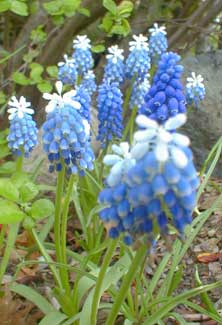
'Mount Hood' Grape Hyacinth;
or. Aucher's Gyongyike
"Yet thou art not inglorious in thy fate;
For so Apollo, with unweeting hand,
Whilom did slay his dearly-lovĖd mate,
Young Hyacinth, born on Eurotas' strand,
Young Hyacinth, the pride of Spartan land;
But then transformed him to a purple flower:
Alack, that so to change thee Winter had no power!"
-John Milton
(1608-1674)
(1608-1674)
'Mount Hood' grape hyacinth, occasionally abbreviated as 'Mt. Hood,' is a stand-out among other blue muscaris because of the white top. The long-lasting blooms stand six to eight inches high, most numerous in April & May. It is hardy in zones 5 through 8 & with protection to zone 4. It wants full to partial sun, full sun when grown further north, more to the shady side if attempted in Zone 9.
The grassy foliage is four to six inches tall, appearing in late autumn & evergreen through winter, long before spring bloom. The grass dies back late in spring. If interplanted with late-appearing perennials it will provide some winter greenery then bloom before late-spring perennials are taking over the location.
This muscari can be permitted to naturalize in short grass, or under trees, or in sunnier locations. They generally take no attention to thrive, just so long as they are not planted with anything that gets large enough early enough in spring to hide them.
I planted ten bulbs, with numerous bulbils attached, on a garden ledge in partial shade. This area gets moderate watering, & drains rapidly; these bulbs appreciate it dryer during their summer dormancy. They've done splendidly.
Although 'Mount Hood' grape hyacinth is randomly listed as either Muscari armeniacum or M. aucheri, the Royal Horticultural Society plant database has tentatively settled on it being M. aucheri. It is more rarely listed as M. tubergenianum, which is an outdated synonym for M. aucheri. Many vendors, themselves confused by these names, issue catalogs with the species of 'Mount Hood' not indicated.
Aucher's Grape Hyacinth is native to Turkey. It is named for the 19th Century French botanist & cultivator Pierre Martin Remi Aucher-Eloy (1792-1838), who collected & studied plants of Turkey, Syria, Iraq, Egypt, Asia Minor & Arabia. He was one of the first Europeans ever to ascend Mount Ararat.
The regular species M. aucheri has blue fertile florets topped by paler blue sterile florets, but for 'Mount Hood' the cap of sterile forets are snowy white atop the the cobalt blue pyramid. Its snow-capped mountain appearance is what lent it its cultivar name, after what is probably the most beautiful of all the mountains in Oregon, & certainly the tallest at 11,237 feet.
The dormant volcano which lent this muscari its name was itself named after an admiral in the British Navy, Sir Samuel Hood (1724-1816). The mountain was so-named in 1792 by Lieutenant William Broughton who was on the voyage with Captain George Vancouver into the Pacific Northwest.
They also visited us here in what was to becoome the county of Kitsap, Washington, today the home of Granny Artemis & Paghat the Ratgirl, the county being separated from the main pennnsula by Hood Canal, named after the Admiral as well.